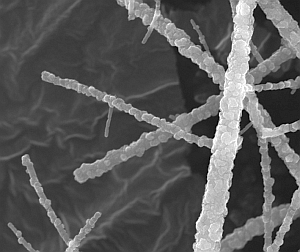Engineering and chemical researchers at University of Illinois in Champaign developed a nanoscale fiber that, when woven into a material, can adsorb sulfur from petroleum-based fuels more efficiently than current methods. The team from the labs of chemistry professor Prashant Jain and the late engineering professor Mark Shannon published their findings online in the journal Nature Nanotechnology (paid subscription required).
Sulfur compounds in fuels release toxic gases during combustion, which damage metals and catalysts in engines and fuel cells. Currently, a liquid treatment can adsorb the sulfur from the fuel, but the cumbersome process requires that the fuel be cooled and reheated, making the fuel less energy efficient. Solid metal oxide pellets can adsorb the sulfur compounds at high temperatures, removing the need for cooling and reheating, but they break down and become ineffective after a few uses.
From previous work, the researchers knew the surfaces of solid oxide adsorbents were the effective areas of the pellets in dealing with the sulfur compounds. Thus their examination focused on creating a material with a high surface area. The team’s research led to spinning grains of zinc titanate — a zinc and tin oxide compound — into nanoscale fibers.
The team found the zinc titanate nanofibers offered the high surface area, high reactivity, and structural integrity needed to work as an effective sulfur adsorbent. The high surface area and reactivity makes it possible for smaller quantities of the nanofiber to completely remove sulfur from fuels, thus requiring a smaller reactor for fuel processors. Jain notes that “under operating conditions, nanobranches grow from the parent fibers, enhancing the surface area during operation.”
Likewise, the material retains its stability and can stay active longer than the current solid metal oxide pellets. Still another advantage of the nanofiber is its integrity, which keeps the zinc titanate nanofibers from clumping, a problem with other forms of nanomaterials.
Jain’s lab plans to focus further research even more precisely, down to the individual atomic level, to learn more surface properties of the nanofibers. “We are interested in finding out the atomic sites on the surface of the material where the hydrogen sulfide adsorbs,” says Jain. “The atomic or nanoscale insight we gain from this material system could be useful to design other catalysts in renewable energy and toxic gas removal applications.”
Read more:
- High-Tech Sheet Fabric Developed to Reduce Bed Sore Risk
- Nanotech Process Developed to Detect Heavy Metal Pollution
- Composite Nanofibers Developed for Orthopedic Biomaterials
- Nanotech Coating Helps Reduce Flames in Polyurethane Foam
- Clinical Trial: Glass Nanofibers Aid Wound Healing
* * *


 RSS - Posts
RSS - Posts
[…] Nanotech Fibers Remove Sulfur from Petroleum Fuels […]
[…] Nanotech Fibers Remove Sulfur from Petroleum Fuels […]
[…] Nanotech Fibers Remove Sulfur from Petroleum Fuels […]